

Without invoking any part of Active Directory (and making the Windows Client far more cumbersome than it needed to be), this system created a kind of default home network user template that applied in most situations, creates the trusts that most users would expect, and gives users easier ways to adjust those trusts when necessary. Thus rather than forcing home users to wrestle with enterprise-quality network resources, but just have them wrestle with it the same way every day until they get accustomed to it, the engineers came up with an idea called "Castle," whose legacy is a mention in Microsoft's pre-release privacy statement for Longhorn testers. So the trust situations between home network components should be fairly straightforward. And they want other people's equipment to stay off of their network. They want portable components and devices to know they're on the network when they're in range or plugged in, and for the network to know when they're gone. If they do mean to hide something from accessibility, users want the ability to do so explicitly, but only when it's necessary.

They want any resource to be visible to the entire network (why would you want to hide a printer?). They want all their machines to share content with one another. In Microsoft laboratory projects that first came to light during the "Code Name Longhorn" project in 2003, engineers found themselves reasoning this way: There's only a few basic principles that home network users want to see implemented anyway. You can't make Active Directory simple enough for everyday home users to want to wrestle with it, or even for sophisticated network admins to want to deal with the same dredge when they get home. Business networking has evolved into a very complicated context that cannot be made simpler or more palatable or livable through the use of any metaphor you can come up with. There's no reason that the experience of setting up networking equipment at home should be a subset of the pain and misery businesses sustain when they toil and sweat over Vista. Maybe they should have been part of Vista to start with. So with a reasonable degree of confidence that the Win7 RC is much more than half-baked, today Betanews begins a continuing series looking into what we believe to be the ten most important new features that Win7 brings to the table - features that represent significant changes to the platform we've been calling Vista, and changes which appear very likely to be improvements.


 0 kommentar(er)
0 kommentar(er)
